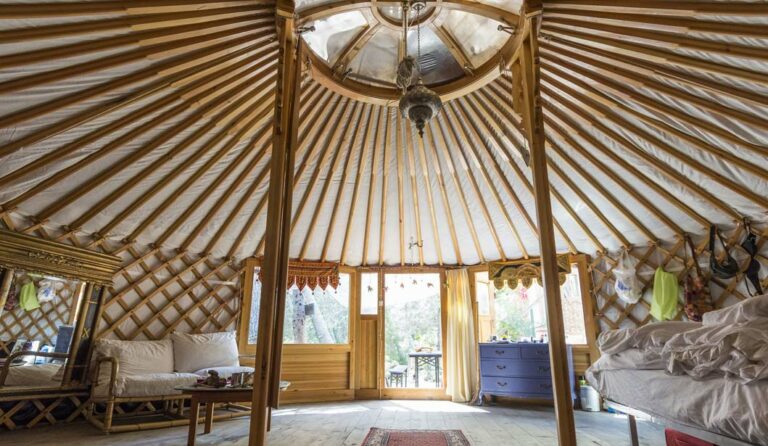If you are thinking “sure! I’m happy to spend the warm summer nights in a yurt, but winter? Snow on the ground outside? No way, jose!” you’re not alone. Certainly it is easy to think you’ll have to have a yurt full of fur to keep you warm. However, yurts are actually extremely energy efficient. So before you cross off any winter yurt vacations from your list, read on for more info on how to stay warm and cosy.
Make sure your yurt is structurally insulated
Whilst perhaps you can get away with a cheaper yurt for casual use in the summer months, you will need to be a bit more diligent about a winter use yurt. Key elements to look for in a yurt is good insulation. You’ll need a reliable heating source and a backup. You’ll also need to ensure your structure is protected from strong winds with secure and tight fastenings and structural support. You can add additional strengthening to the central column and rafters.
Insulate your floor too. We all know the dread feeling of stepping onto a cold floor in the middle of the night. The ground will suck out a lot of heat so the more you insulate from below, the better. And wear thick socks!
Woodstove heating tips
A good woodstove is a great way to keep your yurt warm and toasty. You’ll need to have proper stove pipe to take the smoke out of the yurt. It is important that you monitor carbon monoxide levels too. Carbon monoxide poisoning particularly occurs when the fuels aren’t burned off fully in an area of poor ventilation. You can’t smell it and it can render you unconscious very quickly. To protect yourself, install a carbon monoxide detector and test the batteries regularly. This is one safety tip you don’t want to skip. The size of the stove will depend on the size of the space you want to heat. You don’t want to be living next to a giant furnace but equally if the wood stove is too small you won’t be able to burn enough wood to keep it going all night long.
Make the most of natural elements
Use mother nature to help optimise the warmth in your yurt. The placement is extremely important. Ideally you should be sheltered from the wind. Figure out the sunniest place to make the most of the sunshine in the day time. This is especially important if you plan to use solar panels to provide energy and warmth. If you find yourself surrounded by snow, don’t clear it away from around the base of the yurt. Snow will act as an insulator from the wind. It will help to keep the warmth in and the cold out. But do make sure you regularly remove snow from the roof or it could cause structural damage from the weight.
Clearly from the tradition of yurts use in high altitudes in sub zero temperatures, winter should be no obstacle to your enjoyment! Preparation is key. Stay warm!
